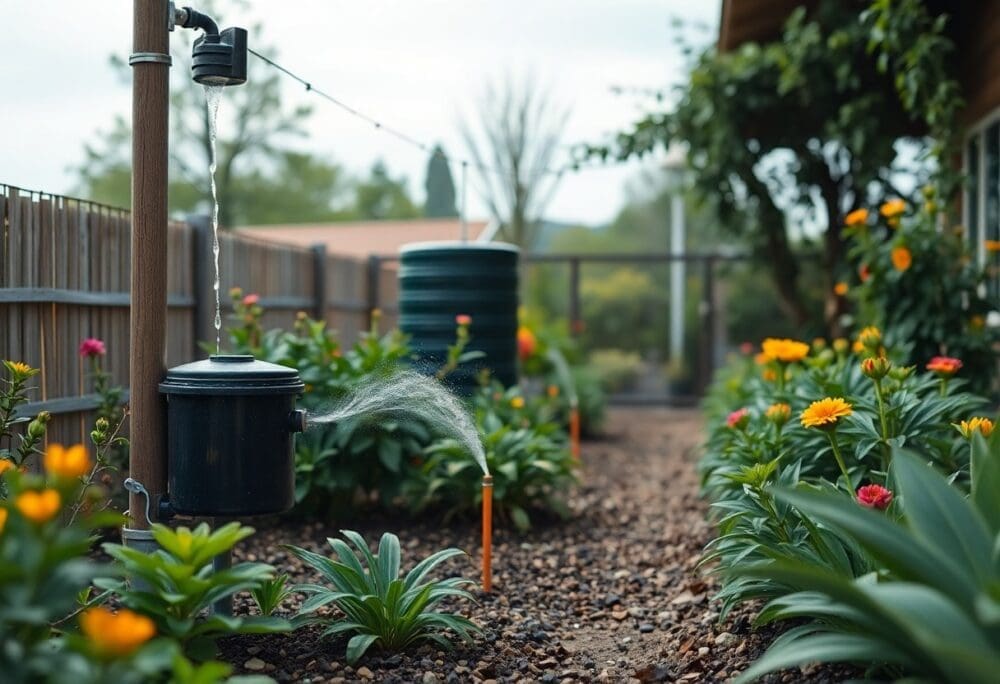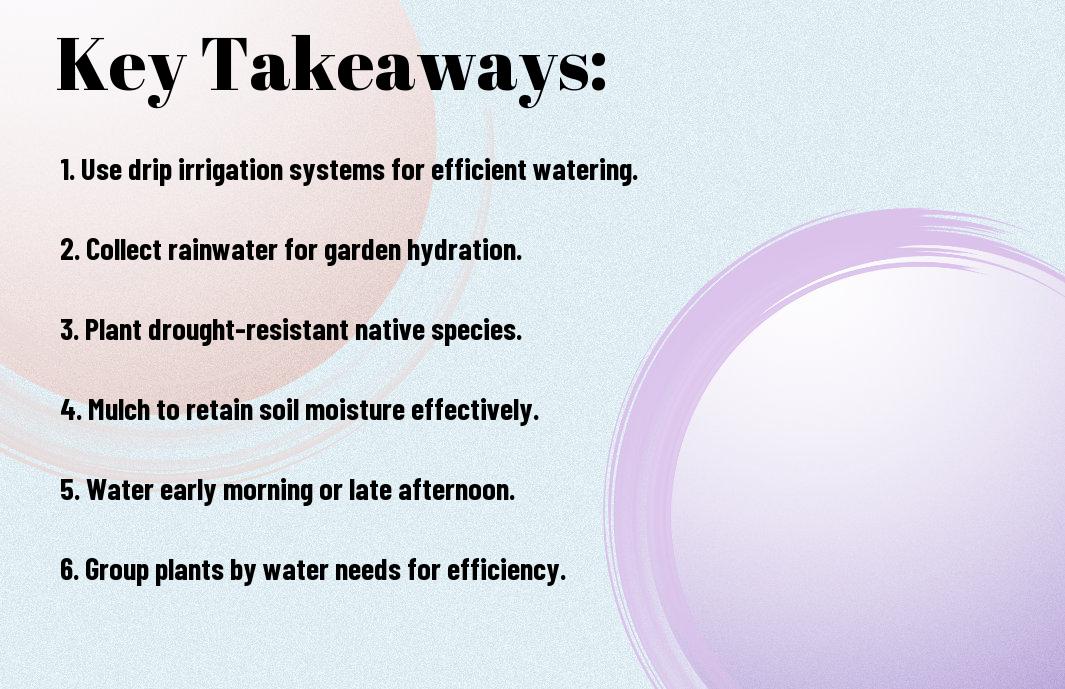Water efficiency is vital for maintaining a thriving garden while protecting our precious resources. By implementing strategic techniques, you can reduce your water usage without sacrificing the health and beauty of your plants. In this article, you’ll discover practical tips that will help you create a sustainable garden that supports both your local ecosystem and your gardening goals. From choosing the right plants to optimizing irrigation methods, these strategies will empower you to cultivate your green space with care and intent.
Key Takeaways:
- Utilize drip irrigation systems to deliver water directly to plant roots, minimizing evaporation and runoff.
- Incorporate drought-resistant plants in your garden design, as they require less water and are more resilient to dry conditions.
- Collect rainwater using barrels to irrigate your garden, providing a sustainable water source that reduces reliance on municipal supplies.
Understanding Water Needs
For sustainable garden projects, understanding the water needs of your plants is crucial in minimizing waste and maximizing growth. You should evaluate the specific requirements of each plant species, taking into consideration factors like climate, soil type, and growth stage. By tailoring your watering practices to match these needs, you can cultivate a healthy garden while conserving water resources.
Assessing Soil Moisture
Assessing soil moisture accurately enables you to determine when your plants require watering. Before you water, stick your finger about an inch into the soil. If it feels dry, it’s time to hydrate; if it remains moist, wait a bit longer. This simple technique helps you avoid overwatering and ensures that your plants receive the right amount of moisture to thrive.
Choosing Drought-Resistant Plants
Against a backdrop of climate variability, choosing drought-resistant plants is a strategic way to reduce your garden’s water consumption. These plants are typically adapted to thrive on minimal moisture, making them less demanding and more resilient during dry spells. By incorporating these species into your garden, you can create a vibrant landscape that flourishes while using significantly less water.
Understanding the characteristics of drought-resistant plants can significantly aid in your selection process. Many native plants have evolved to be highly efficient in water usage, making them ideal for sustainable gardening. Additionally, various succulents and ornamental grasses require minimal hydration while still providing aesthetic appeal. By opting for drought-resistant varieties, you foster a sustainable gardening environment that aligns with water conservation efforts and supports local biodiversity.
Efficient Watering Techniques
Some effective watering techniques can significantly reduce water waste in your garden. Employing methods such as early morning or late evening watering minimizes evaporation and allows your plants to absorb moisture more efficiently. Additionally, here are Water Saving Tips for Spring Gardening that can guide you towards sustainable practices.
Drip Irrigation Systems
About drip irrigation systems, they deliver water directly to the plant’s roots, reducing evaporation and runoff. You can customize these systems to suit your garden layout, ensuring efficient moisture distribution while conserving water resources.
Rainwater Harvesting
Above ground, rainwater harvesting captures and stores rain from rooftops or other surfaces, providing a free and eco-friendly water source for your garden. This method not only conserves water but also reduces your water bills.
Plus, implementing a rainwater harvesting system can enhance your garden’s sustainability. Set up barrels or cisterns to collect rainwater, and use this stored water for irrigation. This practice not only safeguards you from water scarcity but also promotes a more self-sufficient gardening approach. Make sure to include a filtration system to ensure the water is clean before use on your plants.
Mulching for Moisture Retention
Not only does mulching help retain moisture in your garden, but it also suppresses weeds and improves soil health. By layering organic materials such as wood chips, straw, or shredded leaves around your plants, you create a barrier that reduces evaporation and keeps the soil temperature consistent. This simple practice makes your garden more resilient to dry spells, ensuring your plants remain healthy with less frequent watering.
Benefits of Organic Mulch
Against the backdrop of a drying climate, organic mulch provides numerous benefits for your garden. It enriches the soil as it breaks down, enhances biodiversity by attracting beneficial organisms, and regulates soil temperature. Moreover, using organic materials helps in retaining moisture, ensuring that your plants stay hydrated, which ultimately leads to improved growth and productivity.
Implementing Mulch Effectively
Between different types of mulch, choosing the right one and applying it correctly can significantly impact your garden’s health. Aim for a layer of 2 to 4 inches thick, and ensure that you leave space around plant bases to prevent rot. Regular maintenance of the mulch layer is crucial to maintain its benefits.
Hence, implementing mulch effectively requires you to assess your garden’s specific needs. Consider the types of plants you are growing, local climate conditions, and the materials at your disposal. For example, if you have acid-loving plants, pine needles might be the best choice, while hardwood mulch can benefit a variety of garden beds. Regularly replenishing your mulch every season will ensure that it continues to provide moisture retention and other benefits, keeping your garden thriving sustainably.
Smart Landscaping Choices
Now is the perfect time to rethink your landscaping to enhance water conservation. By making thoughtful choices in your garden’s design, such as selecting native plants and implementing efficient irrigation methods, you can create a vibrant outdoor space that minimizes water usage while thriving in your local climate. Adopting smart landscaping techniques not only helps foster sustainability but also reduces maintenance efforts and costs over time.
Xeriscaping Principles
After understanding the foundation of xeriscaping, you can effectively design your garden to minimize water needs. This approach emphasizes selecting drought-tolerant plants, improving soil quality, and strategically designing your layout to facilitate water retention. By following xeriscaping principles, you create an environmentally-friendly garden that requires less water without compromising beauty or functionality.
Grouping Plants by Water Needs
Before you start planting, consider how different plants use water. Grouping plants with similar water requirements together can optimize irrigation efficiency and reduce wastage. By arranging your garden in this way, you ensure that each plant receives the right amount of moisture, leading to healthier plants and a more sustainable garden overall.
Due to the varying water demands of different plants, grouping them strategically is imperative for an efficient watering system. For instance, placing drought-tolerant species alongside native plants that thrive in your region can help create microclimates that conserve moisture. This thoughtful arrangement minimizes evaporation and encourages healthy plant growth, allowing you to maintain a lush garden with less frequent watering, ultimately benefiting both your ecosystem and your water usage.
Seasonal Water Management
To optimize water usage in your garden throughout the year, it’s imperative to adapt your watering practices to seasonal changes. During hot summer months, you should increase your watering frequency, whereas, in cooler months, you can reduce it significantly. Incorporating rainwater harvesting and scheduling irrigation during the early morning or late evening can further enhance your water conservation efforts, ensuring that your plants receive adequate moisture without excess waste.
Adjusting Watering Habits
Against popular belief, not all plants require the same amount of water throughout the seasons. You should actively monitor soil moisture and adjust your watering schedule accordingly. Grouping plants with similar water needs together can simplify this task. You’ll be surprised how a few thoughtful adjustments can lead to more efficient water use.
Seasonal Plant Care Practices
Care for your plants varies by season, and implementing tailored practices can further conserve water. For example, in spring, you should focus on soil preparation and mulching to reduce evaporation, while summer calls for deeper, less frequent watering to encourage root growth. In fall, consider planting cover crops to improve soil health and capture moisture during winter rains.
Also, seasonal practices like deadheading, pruning, and weeding enhance plant resilience and minimize the need for supplemental water. In winter, you can take advantage of a dormant period by avoiding unnecessary irrigation, allowing nature to replenish moisture. By aligning your care routine with seasonal changes, you can create a thriving garden while conserving water efficiently.
To wrap up
On the whole, incorporating water conservation practices in your garden projects can significantly enhance sustainability. By utilizing techniques such as drip irrigation, mulching, and native plants, you can minimize water usage while promoting a thriving garden. Additionally, capturing rainwater and implementing efficient watering schedules will further contribute to your efforts. By adopting these tips, you not only ensure a healthy environment but also create a more resilient space that flourishes with minimal water resources.
Q: What are some effective methods for collecting rainwater for my garden?
A: Collecting rainwater is a great way to conserve water in your garden. You can install rain barrels under the downspouts of your roof to capture runoff. Make sure the barrels have a lid to prevent debris and mosquitoes from entering. Additionally, you can create a rain garden by grading the landscape to collect rainwater in specific areas where plants that thrive in wet conditions can grow. This method not only conserves water but also benefits your garden by managing runoff effectively.
Q: How can I choose drought-resistant plants for my sustainable garden?
A: When selecting drought-resistant plants, look for native species that are adapted to your local climate. Research plants that require less water and are known for their resilience. Xeriscaping is a landscaping approach that emphasizes water-efficient practices and often includes succulents, ornamental grasses, and other low-water plants. Additionally, consult your local garden center or extension service for recommendations on suitable plants for your region.
Q: What irrigation techniques promote water conservation in garden projects?
A: Implementing efficient irrigation techniques can significantly reduce water usage in your garden. Drip irrigation systems deliver water directly to the roots of plants, minimizing evaporation and runoff. Soaker hoses are another effective option, as they slowly release water along their length, ensuring deep watering. Additionally, consider watering your garden in the early morning or late evening when temperatures are cooler, which helps reduce evaporation. Using mulch around your plants can also retain moisture and minimize the need for frequent watering.






